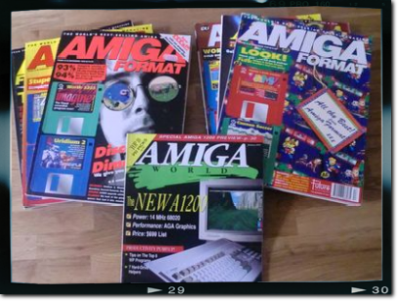16 bit processor, 512mb memory, 4,096 colours,
and full stereo sound.
During 1986, I had the choice of two computers. There was the Atari ST, and the Commodore Amiga 500. I spent a whole morning in a computer shop in Slough comparing one against the other. At the end of three hours, both the shop manager and myself had come to the same conclusion. The Amiga was by far the more advanced and impressive machine. When I called back into the shop a couple of weeks later, he had dropped the Atari ST completely, in favour of the Amiga.
The Amiga came bundled with a large selection of software, including a paint program called Deluxe Paint. Although the Amiga was capable of displaying 4,096 colours, Deluxe Paint was only capable of woring with 64. At this point, the only limitation is the memory size. The higher the screen resolution, and the more colours used, means more memory is required.

To start with, the Amiga's screen size was fixed to the American format, but with software fixes and updates, it was soon posible to display a full screen on a UK tv or monitor. Of course, the bigger screen size also means more memory sucked up to run it. This was soon resolved when Commodore produced a 512mb expansion module. This plugged into an expansion port located underneath the computer. At around this time, a new paint program arrived on the scene, called Photon Paint, and with the extra memory, this allowed you to use all 4,096 colours on screen at once.
With its industry standard interfaces and file formats, it was easy to connect additional drives and printers to the Amiga. Initially, I had to use my tv to as the computer display.

During the late 1980's and early 1990's, there was a huge selection of magazines just for the Amiga computer, and before long the coverdisk made it debut. It was through the coverdisks that I was able to explore the world of computer generated art, and 3D graphics.
The coverdisk programs tended to be demos and "work in progress" examples, but it wasn't long before usable software began to appear. For example; an early 3D landscape generator called Vista, and an early 3D drawing program called Sculpt 3D. With Vista, it was posible to import the US DEM files, and reproduce actual locations, like the Grand Canyon. The finished result, at that time, was quite amazing.
But eventually, even the 1mb Amiga was starting to struggle with some of the newer, more sophisticated software.